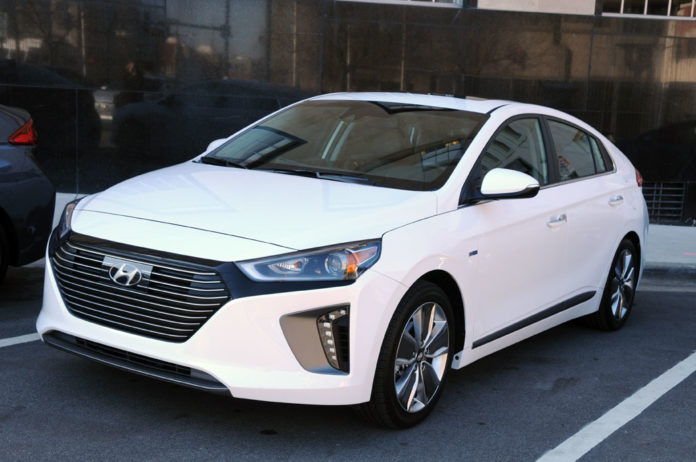“TRES MANERAS DE SER MEJOR” anuncia la marca y es verdad, usted decide entre las tres opciones: el totalmente eléctrico (Electric), el híbrido (Hybrid) y el híbrido de conexión (Plug-In)
(English below)
Los modelos IONIQ de la marca coreana Hyundai fueron presentados en Carolina del Norte, en la emblemática ciudad de Durham por el Gerente de Planificación de Productos, John Y. Shon.
El alojamiento no podía ser más acogedor, en el 21c Museum Hotel (ver nuestra sección Tourism), y la conducción fue por los hermosos parajes campestres en las afueras de la ciudad.
TRES OPCIONES: Las tres posibilidades del IONIQ, un automóvil con una carrocería similar a su hermano Elantra en las dimensiones.
Ancho: Ioniq 70.9, Elantra: 71.7
Alto: Ioniq 56.5, Elantra: 56.9
Largo: Ioniq 179.9, Elantra: 176.0
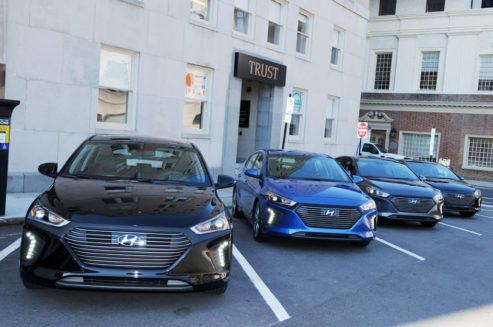
Esto le otorga a usted una visión para comparar un modelo muy conocido como el Elantra con este nuevo modelo de la marca, y directamente comparable con el Toyota Prius (69.3 de ancho), inches más o menos, al entrar a un IONIQ, se nota más holgado.
El manejo fue con mi compañero de prueba, Roger Rivero que explica en el video más abajo las propiedades del Electric (rinde 136 millas por carga), por lo pronto, muy confortable y con el augurio que tendrá muchos compradores, especialmente cuando los números sumen y resten en ahorro de gasolina. Lo mismo podrá ocurrir para quien decida por un Hybrid, que llegaría a dar 58 millas por galón.
DISEÑO ECOLÓGICO: Los amantes de lo “green” estarán complacidos con estas ofertas. Un paso más para una vida mejor, sin polución. Asimismo se sorprenderán al saber los detalles que, desde telas biológicas hasta plásticos reciclados, fueron usados para crear el revestimiento del reposacabezas, las alfombras y los bordes decorativos de la puerta, incluso el interior del IONIQ muestra su lado ecológico como:
-Caña de azúcar. La caña de azúcar representa el 25% de la materia prima usada en los paneles decorativos, suaves al tacto del interior.
-Piedra volcánica. El uso de plástico reciclado combinado con madera y piedra volcánica pulverizadas reduce el peso de algunos plásticos interiores hasta en un 20%.
La carrocería tiene un uso inteligente de aluminio y acero avanzado de alta resistencia que le dan a cada modelo del IONIQ un cuerpo con una estructura más ligera y rígida. Esta mezcla de materiales resistentes, que ahorran peso, ayudan a que todos estos modelos usen menos energía al desplazarse. Menos peso se traduce en un “Millas Por Galón” más alto con un mejor rango y aceleración.
La Seguridad: En cuanto a seguridad, tiene el frenado de emergencia automático con detección de peatones, la advertencia de salida de carril y la detección de puntos ciegos. Y en cuanto a tecnología el Control Crucero Inteligente, integración de smartphone y recarga inalámbrica. Incluso hay un lugar para sostener su tableta entre los asientos delanteros.
Los precios varían desde $22.200, a $30.500 los Hybrid, y desde $29.500 a $36.000 los Electric, precios básicos sin las opciones.
HYUNDAI IONIQ 2017
The eco-focused IONIQ is the first vehicle to offer three distinct electrified powertrains on a single, dedicated vehicle platform.
The driving experience inside Ioniq is enhanced through state-of-the art connectivity features like Apple CarPlay, Android Auto and Blue Link, as well as wireless charging for smartphones. Even more, the 7-inch TFT instrument cluster displays all key driver information with outstanding resolution. Ioniq also offers the very latest in advanced safety, including Automatic Emergency Braking with Pedestrian Detection, Lane Departure Warning, Blind Spot Detection and Rear Cross-Traffic Alert, for high levels of both active and passive vehicle safety.
Ioniq models offer a sleek, aerodynamic silhouette with an industry-leading 0.24 Cd derived from carefully designed surfaces. Its fluid exterior shape and smooth air flow channels emphasize aerodynamic body lines and design forms.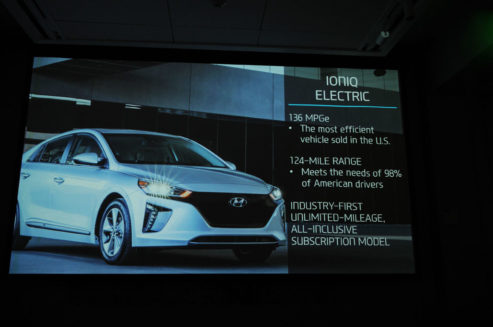
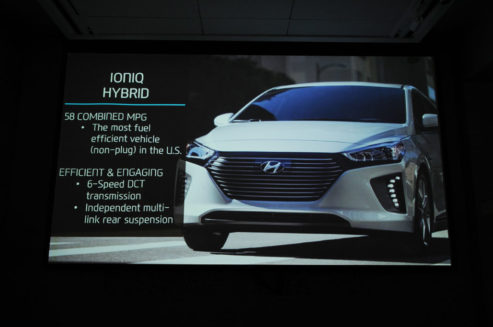 The Ioniq Hybrid and Ioniq Plug-in Hybrid both feature a new Kappa 1.6L direct-injected Atkinson-cycle four-cylinder engine with an unsurpassed thermal efficiency of 40 percent, delivering an estimated 104 horsepower and an estimated 109 lb.-ft. of torque. The high-efficiency electric motor can operate at speeds up to 75 MPH and delivers instantaneous torque at low speeds, with available power-assist at higher vehicle speeds.
The Ioniq Hybrid and Ioniq Plug-in Hybrid both feature a new Kappa 1.6L direct-injected Atkinson-cycle four-cylinder engine with an unsurpassed thermal efficiency of 40 percent, delivering an estimated 104 horsepower and an estimated 109 lb.-ft. of torque. The high-efficiency electric motor can operate at speeds up to 75 MPH and delivers instantaneous torque at low speeds, with available power-assist at higher vehicle speeds.
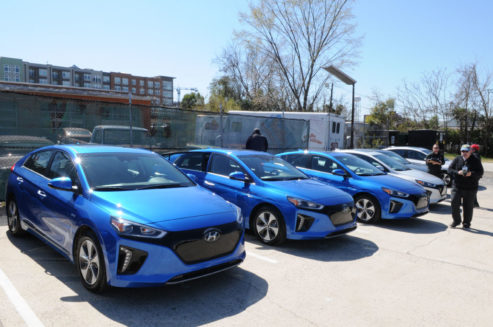
The Ioniq Hybrid’s electric motor delivers an estimated 32 kW (43 horsepower) with an estimated maximum torque of 125 lb.-ft., powered by a lithium-ion polymer battery with 1.56 kWh capacity. The battery is efficiently positioned under the rear passenger seats. In combination with the 1.6-liter direct-injected engine, Ioniq Hybrid offers a total system output of 139 horsepower while providing low emissions, outstanding efficiency and range. The Ioniq Hybrid Blue model has an EPA-estimated 58 MPG combined rating, the highest rating of any non-plug-in vehicle sold in the U.S. market.
The Ioniq Plug-in Hybrid provides an all-electric range of more than 27 miles based on preliminary internal estimates, powered by a potent 8.9 kWh lithium-ion polymer battery. The Ioniq Plug-in Hybrid’s estimated 45kW (60 horsepower) electric motor is coupled with the 1.6 direct-injected Atkinson four-cylinder Kappa engine.
The Ioniq Electric offers pure electric mobility with a 28 kWh lithium-ion polymer battery for an estimated driving range of 124 miles. The electric motor has a maximum output of 88 kW (118 horsepower) and 218 lb.-ft. of torque mated to a single-speed reduction-gear transmission. The Ioniq Electric has an EPA-estimated 136 MPGe rating, the highest efficiency rating of any electric vehicle sold in the U.S. market.
Advanced Battery Technology : Further, the powertrain components were designed to be compact and highly efficient. The combined extra weight of the Hybrid and Plug-in Hybrid technology therefore adds minimal weight to the Ioniq, but significantly increases its efficiency.
Electric power for the Hybrid and the Plug-in Hybrid, as well as for the Electric, is generated by a permanent magnet synchronous motor whose parts were optimized by reducing the thickness of core components by up to 10 percent and adopting rectangular-section copper wire to decrease core and copper loss. Hyundai uses a lithium-ion polymer battery pack for all Ioniq models which is 20 percent lighter than non-polymer lithium-ion batteries and can be shaped more optimally to the interior than standard cell format batteries. This also provides lower memory sensitivity, excellent charge and discharge efficiency, and outstanding maximum output.

All Ioniq Electric models are equipped with standard Level-3 DC fast-charging capability. Charging the Ioniq Electric’s lithium-ion polymer battery up to 80 percent only takes approximately 23 minutes using a SAE Combo Level-3 DC, 100 kW fast charger. An integrated In-Cable Control Box (ICCB) also allows drivers to charge their Ioniq using a standard household electric socket.



